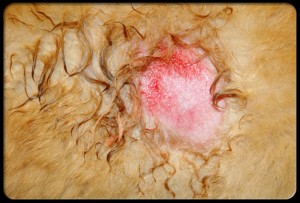Food Allergy In Dogs And Cats: Signs, Causes And Natural Solutions
Food allergy causes a number of effects on dogs and cats, the most common being itchiness of the skin. This is one of the most common, and most frustrating medical condition affecting primarily dogs, but also cats. In this article, you’ll learn what the most common causes of food allergies in dogs and cats are, including the typical signs. Lastly you’ll find out what are the best foods to feed if your dog or cat has a food allergy.
In both people, and dogs and cats, the incidence of allergies is increasing. Food allergy is one of the itchiest conditions known to cats and dogs. The more common signs include: itchiness, constant or intermittent scratching, chronic paw licking, skin rashes, and recurring ear infections. There may be respiratory signs such as runny eyes and nasal discharge. In a small number of dogs and cats there are intestinal signs of vomiting and diarrhea.
Proteins in the food become recognized by your pet’s immune system as foreign, and are attacked. This causes inflammation which usually shows up in the skin, but also can show up in the intestinal tract as vomiting, diarrhea. Other organs can also be involved if they are attacked by the immune system.
In diagnosing food allergies in pets, there are a number of criteria that veterinarians use, such as history, clinical signs and the response to treatment. It is a good idea to rule our sarcoptic mange in dogs by treating for it with a conventional medication, such as selamectin (Revolution). Most food allergies are non-seasonal, meaning they happen year round. Atopy or inhalant allergy on the other hand usually starts out non seasonal, then progresses to becoming seasonal. Lastly you must consider the age at which the allergy starts: most food allergies start in dogs and cats at the age of 5-6 years, while atopy starts at 1-3 years.
In dogs the most common allergens are beef, chicken, egg, cow milk, wheat, soy, fish, rice, potato and corn. Most dogs (in one study it was 80%) of the dogs react to just one or 2 food items. In cats the most common allergens are chicken, fish, dairy products, plus common carbohydrates, including wheat, rice and corn.
Here we are feeding a hypoallergenic diet for 10-12 weeks to see if we can have your dog or cat’s allergic symptoms stop. The big point here is to feed a novel protein and ingredient source that your dog or cat has not been fed, and least likely to be allergic to. For dogs I encourage you to avoid these ingredients first: beef, chicken, egg, cow milk, wheat, and corn. For cats avoid these ingredients: chicken, fish and dairy and all the carbohydrates. Commercial diets that I have had success for in dogs include unique ingredients such as fish and sweet potato. Commercial diets for cats need to be animal protein based – I prefer one that is poultry, but not chicken, such as turkey or duck.
Then there the hypoallergenic diets made from protein that is broken down into small molecules that don’t cause an immune system reaction. These seem to be effective for a number of the allergic dogs and cats, but can become cost prohibitive, especially if you are dealing with a large breed dog. Avoid feeding any treats that your pet may be allergic to – I prefer that you give the food as a treat, dried liver or vegetables (such as carrots).
You should now have a better understanding of what food allergy in dogs and cats is, including how it happens. Now you can better see the criteria that your veterinarian uses to diagnose your pet with a food allergy, including the more common allergens. Lastly you now know what specific foods to feed for the appropriate period of time, if food allergy is suspected.

Cant dogs get dandruff too? Do you have any information on the pet flea deterrent, frontline plus?
Would you please list some wet and dry cat food that I can purchase in stores to try to help my cat with her food sensitivities.
I have also just ordered the cat supplements from your website to assist my cat to relief her from her allergies or food sensitivities.